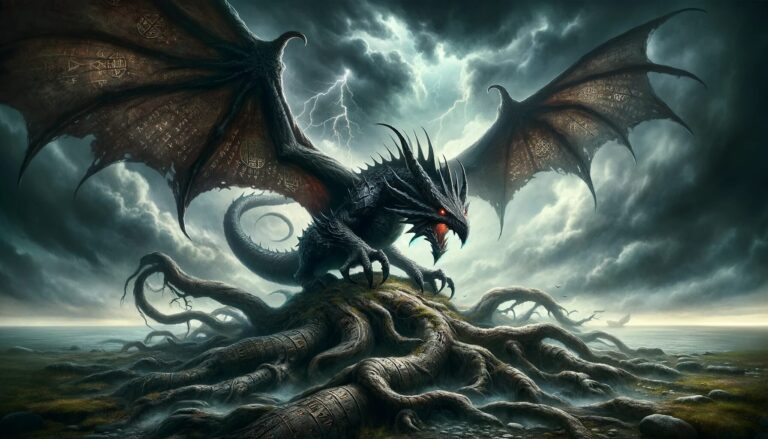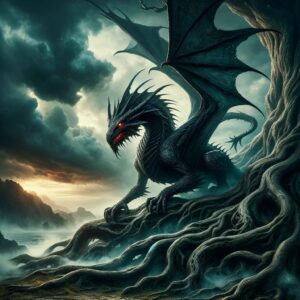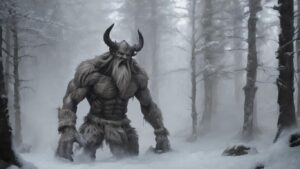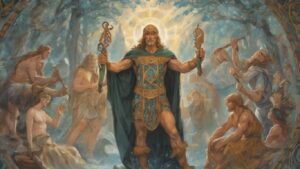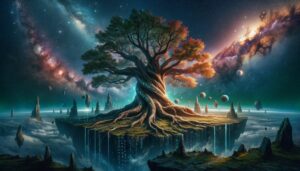Table of Contents
In the rich tapestry of Norse mythology, few creatures are as ominous and enigmatic as Nidhogg, the ferocious dragon that gnaws at the roots of Yggdrasil, the World Tree. This malevolent entity, also known as “the Malice Striker,” resides in the shadowy depths of the Norse cosmos, perpetually locked in a cosmic struggle that symbolizes the delicate balance between order and chaos.
Origins and Family Ties
Nidhogg’s origins shroud themselves in the mist of ancient Norse mythology, and he lacks a known traditional family or lineage. Instead, he emerges as a primordial force, seemingly born from the very fabric of the cosmos. His name itself reveals his nature, as “Níðhǫggr” can be translated as “Malice Striker” or “Curse Striker” in Old Norse, underscoring his malevolent disposition.
While the surviving Norse texts do not explicitly detail Nidhogg’s family lineage, they often associate him with the cosmic entities inhabiting the realms of Norse mythology. Specifically, Nidhogg’s ceaseless activity in gnawing at Yggdrasil’s roots closely ties him to the World Tree and the interconnectedness of the Norse cosmos.
Physical Description
Nidhogg is an awe-inspiring and formidable creature, described in vivid terms in the poetic verses of the Norse sagas. His physical characteristics are both striking and menacing, painting a vivid picture of this ancient being.
This tremendous dragon boasts a gargantuan form adorned with bright scales that shimmer ominously in the dim light of the underworld. Protruding from his skull are menacing horns, a testament to his formidable power and ferocity. While Nidhogg possesses a pair of forelegs, complete with massive claws that enable him to grip the roots of Yggdrasil, his lower body takes on the form of a sinuous and serpentine tail. It is this tail that allows him to navigate the labyrinthine network of Yggdrasil’s roots with sinister precision.
Nidhogg carries the gruesome cargo beneath his bat-like wings, emphasizing his connection to malevolence and death. People often depict the dragon transporting the corpses of dark criminals.
His immense form contorts and twists through the gnarled roots of Yggdrasil, particularly in the vicinity of Niflheimr, the cold and desolate realm from which all the rivers of Midgard spring. Nidhogg may occasionally venture into the bleak and foreboding realm of Hel, where he maintains a mysterious connection with the dark goddess Hel, who some regard as his master.
Abilities
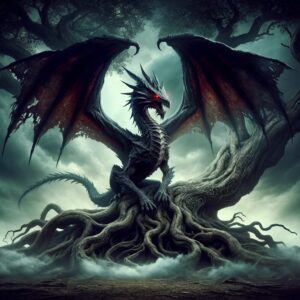
In Norse mythology, Nidhogg’s abilities are intimately tied to his role as a guardian and malevolent force within the cosmos. His abilities include:
Root-Gnawing: Nidhogg’s primary ability is his relentless gnawing at the roots of Yggdrasil, the World Tree. This ceaseless activity weakens the very foundation of the cosmos, posing a constant threat to the stability of the Norse universe.
Cosmic Balance: Paradoxically, Nidhogg’s existence plays a crucial role in maintaining the delicate balance within Norse cosmology. His antagonistic relationship with the majestic eagle perched at the top of Yggdrasil symbolizes the eternal tension between chaos and order, darkness and light, that underpins the Norse worldview.
Role in Ragnarok: Nidhogg’s actions are central to the cataclysmic event of Ragnarok. His successful gnawing through Yggdrasil’s roots triggers the onset of this apocalyptic event, leading to the destruction and subsequent rebirth of the cosmos.
Symbolism
Beyond his abilities, Nidhogg embodies profound symbolism within Norse mythology:
Chaos and Malevolence: Nidhogg stands as a formidable representation of chaos, darkness, and malevolence. His ceaseless efforts to undermine the World Tree serve as a metaphor for the ever-present threat to cosmic stability, highlighting the perpetual struggle between opposing forces.
Balance and Conflict: Nidhogg’s cosmic tension with the eagle symbolizes the overarching theme of balance in Norse mythology. While the eagle represents wisdom and virtue, Nidhogg embodies chaos and malevolence. Their ongoing conflict, fueled by the squirrel Ratatoskr, underscores the necessity of opposition and tension in maintaining equilibrium.
Cycle of Growth: Despite the destructive nature of their conflict, the antagonism between the eagle and Nidhogg serves a profound purpose. It promotes a cycle of growth within Yggdrasil. Each day, the tree bathes in the revitalizing waters from the wells of Urd, symbolizing the potential for renewal and healing even in the face of chaos after relentless destruction.
Punishment and Justice: Nidhogg’s role in punishing criminals in Nadastrond reflects themes of justice and retribution in Norse mythology. The gruesome hall where he feasts upon the bodies of transgressors serves as a terrifying symbol of the consequences of wrongdoing, reinforcing the idea that actions have consequences even in the afterlife.
Ragnarok and Nidhogg’s Role
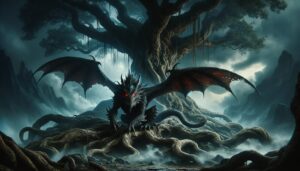
Nidhogg’s ominous presence looms large in the prophesied event known as Ragnarok, the cataclysmic day when the giants will launch an assault on the gods, ultimately leading to the destruction of much of the Norse cosmos. In this apocalyptic scenario, Nidhogg’s actions are central to the unfolding of events.
Ragnarok is foretold to commence when Nidhogg, after eons of relentless effort, succeeds in chewing through the very roots of Yggdrasil. This catastrophic breach triggers a chain reaction, causing the World Tree to wither and the realms it supports to plunge into a three-year winter, shrouding the cosmos in darkness and chaos.
With the roots severed and the cosmic order disrupted, Nidhogg emerges from the underworld, ascending with the souls of the dead criminals he has consumed. Consequently, as a harbinger of destruction and evil, he leads the giants in a final assault against the gods, bringing about a climactic battle that will reshape the cosmos.
Subsequently, in the aftermath of Ragnarok, as the dust settles and the cosmos begins to rebuild itself, Nidhogg endures as a force of malevolence and chaos. As a result, he serves as a grim counterbalance to the forces of good and order in the post-Ragnarok world.
Cultural Representation
Nidhogg’s ominous presence and rich symbolism have not faded with the passage of time; instead, they continue to resonate in various forms of modern culture. His enduring legacy is particularly evident in the realms of literature, visual arts, and gaming.
Literature
Nidhogg is a character deeply embedded in the foundational texts of Norse mythology. He appears prominently in both the Poetic Edda and the Prose Edda, the authoritative sources that provide a wealth of knowledge about the Norse cosmology and its denizens.
The poem Grímnismál in the Poetic Edda introduces Nidhogg through the character Ratatoskr, the squirrel that serves as a messenger between the eagle and the dragon:
“RATATOSKS IS THE SQUIRREL WHO THERE SHALL RUN / ON THE ASH-TREE YGGDRASIL; / FROM ABOVE THE WORDS OF THE EAGLE HE BEARS, / AND TELLS THEM TO NITHHOGG BENEATH.”
Additionally, the poem Völuspá in the Poetic Edda paints a vivid picture of Nadastrond, the realm ruled by Nidhogg:
“A HALL I SAW, / FAR FROM THE SUN, / ON NASTROND IT STANDS, / AND THE DOORS FACE NORTH, / VENOM DROPS / THROUGH THE SMOKE-VENT DOWN, / FOR AROUND THE WALLS / DO SERPENTS WIND. / I THERE SAW WADING / THROUGH RIVERS WILD / TREACHEROUS MEN / AND MURDERERS TOO, / AND WORKERS OF ILL / WITH THE WIVES OF MEN; / THERE NITHHOGG SUCKED / THE BLOOD OF THE SLAIN, / AND THE WOLF TORE MEN; / WOULD YOU KNOW YET MORE?”
These ancient verses vividly portray Nidhogg’s presence in the underworld and his sinister role in the torment of souls.
Visual Arts
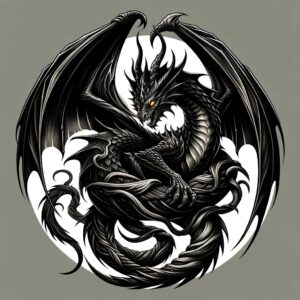
Nidhogg’s formidable and iconic image has captured the imagination of artists and creators in various mediums. Moreover, video games, role-playing games, and visual art have featured him, bringing his menacing form to life with stunning detail and imagination.
One notable example is the indie game “Nidhogg,” where players engage in frenetic duels, embodying the spirit of the dragon in intense battles. Notably, the game’s art style and gameplay mechanics pay homage to Norse mythology, with Nidhogg serving as a central character.
Conclusion
Nidhogg’s Ongoing Legacy
In the labyrinthine realms of Norse mythology, Nidhogg stands as a creature of immense significance. Notably, his relentless gnawing at the roots of Yggdrasil serves as a symbolic representation of chaos, conflict, and the ever-present forces that challenge the cosmic order. However, it’s important to recognize that his existence is integral to maintaining the delicate balance of the Norse cosmos.
Furthermore, from his vivid physical description to his pivotal role in Ragnarok, Nidhogg continues to captivate the imagination and inspire reflection on the themes of cosmic balance, the inevitability of conflict, and the enduring struggle between chaos and order. As a symbol of malevolence and destruction, he reminds us of the multifaceted nature of existence, where even the darkest forces play a vital role in the grand tapestry of mythology and life itself.
Moreover, in literature, art, and gaming, Nidhogg’s legacy endures, ensuring that his fearsome presence remains etched in the annals of cultural exploration. As a Mythical Explorer, I invite you to delve deeper into the realms of Norse mythology and discover the layers of meaning hidden within the scales of this formidable dragon, Nidhogg, the Malice Striker.
FAQ
What does Nidhogg's name mean?
Nidhogg's name can be translated as "Malice Striker" or "Curse Striker" in Old Norse, reflecting his malevolent nature.
What is Nidhogg's role in Norse mythology?
Nidhogg plays a significant role by gnawing at the roots of Yggdrasil, the World Tree, symbolizing chaos and conflict in the cosmos.
Is Nidhogg associated with any specific realm in Norse mythology?
Yes, Nidhogg is often linked to Niflheimr, the cold and desolate realm, and occasionally to Hel, where he has a mysterious connection with the dark goddess Hel.
How has Nidhogg been portrayed in various media and pop culture?
Nidhogg has appeared in video games, role-playing games, and visual art, where artists and creators have depicted his menacing form with great detail and imagination.
What is the significance of Nidhogg's role in Ragnarok?
Nidhogg leads the giants in a final assault against the gods during Ragnarok, contributing to the climactic battle that reshapes the Norse cosmos.
Does Nidhogg survive Ragnarok?
Yes, Nidhogg endures as a force of malevolence and chaos in the post-Ragnarok world, serving as a grim counterbalance to the forces of good and order.
